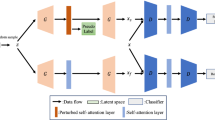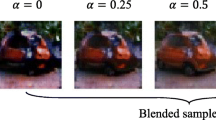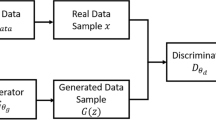Abstract
Mode collapse is a very common issue in Generative Adversarial Networks. To alleviate the mode collapse, we introduce a novel semi-supervised GAN-based generative model and propose a quantitative criterion to describe the degree of mode collapse. We design several schemes in the experiments to observe the effect of semi-supervised learning on mode collapse. In addition, the semi-supervised model can capture both supervised and unsupervised disentangled representation at the same time by introducing similarity constraint loss, so that generated image is higher-quality and more varied. The architecture leverages a few labels to control some factors on the class-conditional representation and captures other interpretable unsupervised representations with a large amount of unlabeled data. Both quantitative and visual results on the CIFAR-10 and SVHN datasets verify the ability of the proposed architecture.










Similar content being viewed by others
References
Arjovsky M, Bottou L (2017) Towards principled methods for training generative adversarial networks. Stat, pp 1050
Augustus Odena Christopher Olah JS (2017) Conditional image synthesis with auxiliary classifier gans. In: International conference on learning representations, pp 2642–2651
Chen X, Duan Y, Houthooft R, Schulman J, Sutskever I, Abbeel P (2016) Infogan: Interpretable representation learning by information maximizing generative adversarial nets. In: Advances in neural information processing systems, pp 2172–2180
Bang D, Shim H (2021) mggan: Solving mode collapse using manifold guided training. In: Proceedings of the IEEE/CVF international conference on computer vision, pp 2347–2356
Goodfellow I, Pouget-Abadie J, Mirza M, Xu B, Warde-Farley D, Ozair S, Courville A, Bengio Y (2014) Generative adversarial nets. In: Advances in neural information processing systems, pp 2672–2680
Gulrajani I, Ahmed F, Arjovsky M, Dumoulin V, Courville AC (2017) Improved training of wasserstein gans. In: Advances in neural information processing systems, pp 5769–5779
Heusel M, Ramsauer H, Unterthiner T, Nessler B, Hochreiter S (2017) Gans trained by a two time-scale update rule converge to a local nash equilibrium. Advances in neural information processing systems 30
Krizhevsky A, Hinton G (2009) Learning multiple layers of features from tiny images
LeCun Y, Cortes C (2010) MNIST handwritten digit database. http://yann.lecun.com/exdb/mnist/
Li W, Fan L, Wang Z, Ma C, Cui X (2021) Tackling mode collapse in multi-generator gans with orthogonal vectors. Pattern Recogn 110:107646
Li X, Chen L, Wang L, Wu P, Tong W (2018) Scgan: Disentangled representation learning by adding similarity constraint on generative adversarial nets. IEEE Access
Li Y, Singh KK, Ojha U, Lee YJ (2020) Mixnmatch: Multifactor disentanglement and encoding for conditional image generation. In: Proceedings of the IEEE/CVF conference on computer vision and pattern recognition, pp 8039–8048
Makhzani A, Shlens J, Jaitly N, Goodfellow I, Frey B (2016) Adversarial autoencoders. In: International conference on learning representations
Mao X, Li Q, Xie H, Lau RY, Wang Z, Paul Smolley S (2017) Least squares generative adversarial networks. In: Proceedings of the IEEE international conference on computer vision, pp 2794–2802
Metz L, Poole B, Pfau D, Sohl-Dickstein J (2017) Unrolled generative adversarial networks. In: International conference on learning representations
Mirza M, Osindero S (2014) Conditional generative adversarial nets. Computer Science, pp 2672–2680
Miyato T, Kataoka T, Koyama M, Yoshida Y (2018) Spectral normalization for generative adversarial networks. In: International conference on learning representations
Netzer Y, Wang T, Coates A, Bissacco A, Wu B, Ng AY (2011) Reading digits in natural images with unsupervised feature learning. In: NIPS Workshop on deep learning and unsupervised feature learning, vol 2011, pp 5
Durall R, Chatzimichailidis A, Labus P (2021) Combating mode collapse in gan training: An empirical analysis using hessian eigenvalues. In: VISIGRAPP, pp 211–218
Russakovsky O, Deng J, Su H, Krause J, Satheesh S, Ma S, Huang Z, Karpathy A, Khosla A, Bernstein M et al (2015) Imagenet large scale visual recognition challenge. Int J Comput Vis 115(3):211–252
Salimans T, Goodfellow I, Zaremba W, Cheung V, Radford A, Chen X (2016) Improved techniques for training gans. In: Advances in neural information processing systems, pp 2234–2242
Salimans T, Goodfellow I, Zaremba W, Cheung V, Radford A, Chen X (2016) Improved techniques for training gans. Advances in neural information processing systems 29
Singh KK, Ojha U, Lee YJ (2019) Finegan: Unsupervised hierarchical disentanglement for fine-grained object generation and discovery. In: Proceedings of the IEEE/CVF conference on computer vision and pattern recognition, pp 6490– 6499
Sohn K, Lee H, Yan X (2015) Learning structured output representation using deep conditional generative models. Advances in neural information processing systems 28
Srivastava N, Hinton G, Krizhevsky A, Sutskever I, Salakhutdinov R (2014) Dropout: a simple way to prevent neural networks from overfitting. J Mach Learn Res 15(1):1929–1958
Szegedy C, Vanhoucke V, Ioffe S, Shlens J, Wojna Z (2016) Rethinking the inception architecture for computer vision. In: Proceedings of the IEEE conference on computer vision and pattern recognition, pp 2818–2826
Villani C (2009) Optimal transport, old and new. grundlehren der mathematischen wissenshaften 338
Zagoruyko S, Komodakis N (2016) Wide residual networks
Zhu Z, Luo P, Wang X, Tang X (2014) Multi-view perceptron: a deep model for learning face identity and view representations. In: Advances in neural information processing systems, pp 217–225
Acknowledgements
This work is supported in part by Shanghai science and technology committee under grant No. 21511100600. We appreciate the High Performance Computing Center of Shanghai University, and Shanghai Engineering Research Center of Intelligent Computing System (No. 19DZ2252600) for providing the computing resources and technical support.
Author information
Authors and Affiliations
Corresponding author
Additional information
Publisher’s note
Springer Nature remains neutral with regard to jurisdictional claims in published maps and institutional affiliations.
Appendix
Appendix
FID and SFID are calculated separately for each category of generated images, but for the final comparison, the average of these numbers is calculated. In the comparative experiments, the features of 3k generated images are selected to fit the generated distribution, and the features of all the testing images were used to fit the real distribution. After that, fid and SFID are calculated according to formula (1). As shown in Tables 6 and 7, the smaller SFID is, the higher the classification accuracy is, which is consistent with our intuitive motivation. In other words, the better the diversity of generated images is, the higher the classification accuracy will be.
Rights and permissions
About this article
Cite this article
Li, X., Luan, Y. & Chen, L. Semi-supervised GAN with similarity constraint for mode diversity. Appl Intell 53, 3933–3946 (2023). https://doi.org/10.1007/s10489-022-03771-2
Accepted:
Published:
Issue Date:
DOI: https://doi.org/10.1007/s10489-022-03771-2




